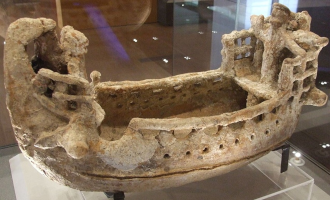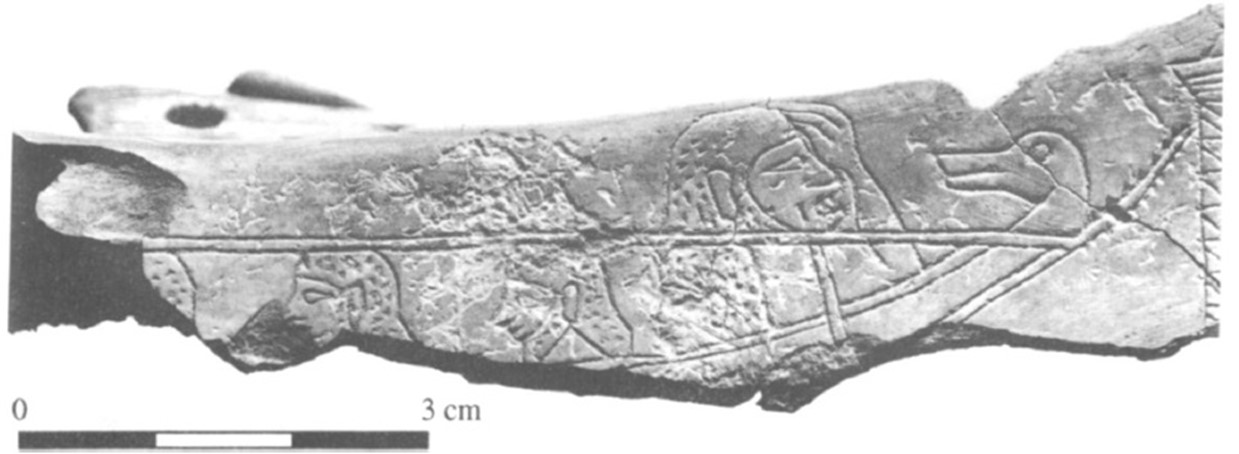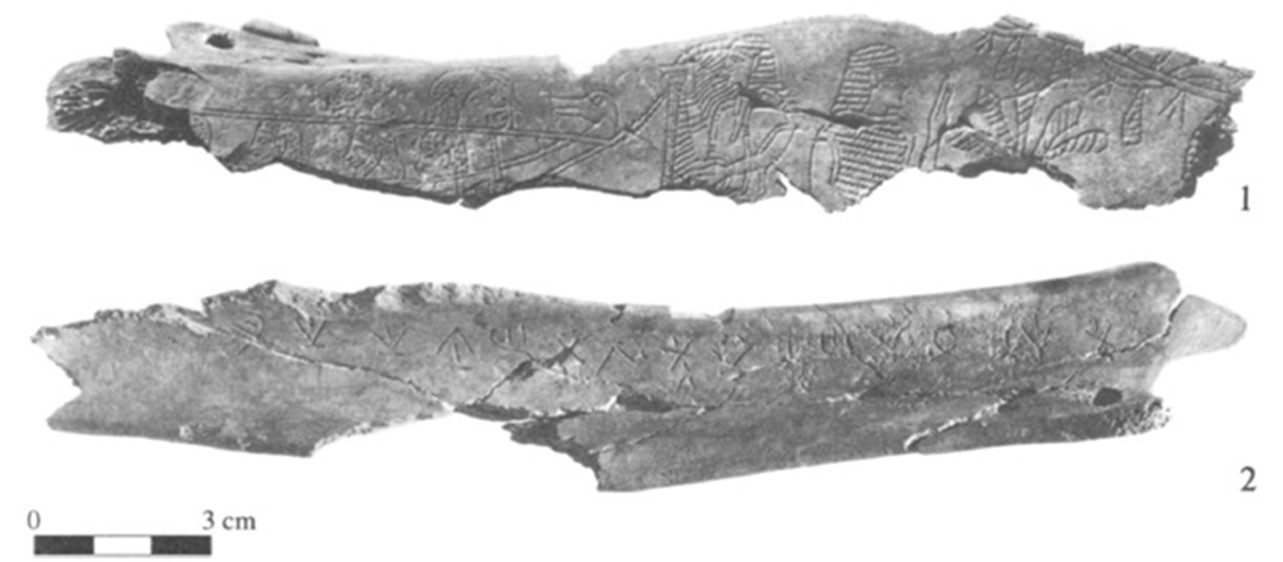The ship is very fragmentary, with only one stem surviving. The composition of the scene which shows a departing ship from the shore to the right indicates that this must be the stern. The ship has a crescentic hull with a concave sheer and a slightly raised post that ends in an inward-facing naturalistic duck head. The sheer is rendered with a thin double line. Immediately above the heads of the seated figures is a horizontal feature that runs the length of the hull and crosses the sternpost, possibly representing a rail. It is connected to another feature composed of two oblique parallel lines that runs along the external edge of the sternpost and extends outward in a straight line beyond the bird-headed device. Its projecting tip has a series of short spikes on either side. Beginning from the horizontal rail near the stern and crossing the hull is an oblique double line which possibly represents the quarter rudder. All of these features are approximately of the same thickness.
Maritime ritual scene
L49
7th-6th century B.C.
Tell Dor, area D2, Persian period pit
L: 23 cm
Right scapula od a large mammal, probably a cow, smoothed and perforated at the edge for suspension
Masson 1994; Stern 1994a; 1994b; Sauvage 2015
Area D2 is located in the southern slope of the mound. The scapula comes from the lower part of a c. 60 cm deep pit, situated in a street running east-west between two Persian period buildings that were part of the commercial/industrial complex. Both of these buildings have two to three construction phases (5th -4th centuries) but it is not possible to correlate the pit to any particular phase since the stratigraphy of the street itself does not necessarily follow that of the buildings. The excavators argue that the pit is likely contemporaneous with the initial phase of the Persian period complex. The scapula was found amongst an assemblage of local and imported (East Greek islands) pottery typical of the Persian period at Dor. Other finds include and egyptianizing amulet and a Phoenician ostracon. There appears to be a tradition of incised scapulae spanning the LBA and EIA in the Levant and Cyprus, often found in cultic contexts and continuing throughout the Archaic period on Cyprus. These have been examined by Reese and are summarized below (Reese 1999). The overwhelming majority of these are merely notches, with only one from Paphos bearing incised decoration such as the one from Dor. One side of the scapula bears an inscription in Cypro-Syllabic script written from right to left in the Paphian variant, probably of Classical date. It consists of the Greek verb "ka-te-te-ke" ("dedicated") as well as the dedicand's name and that of his father. Two other Cypro-Syllabic inscriptions are known from Sarepta and Sidon respectively, which have been similarly interpreted as dedications in Phoenician temples by Cypriote pilgrims.
Maritime scene: The obverse side of the scapula shows a maritime scene composed of two interrelated parts. The left part is occupied by a partially preserved ship which is the central motif of the scene. A row of four heads facing left emerge just above the gunwale. Above the last seated figure nearest to the stem is a man depicted on a larger scale and facing in the opposite direction, towards the shore. Like the other men, he wears an Egyptian-style headdress and is bearded, but his larger size indicates his importance, probably as the captain of the ship. His hand is raised to his forehead in a typical Egyptian expression of devotion or blessing. A priestess stands opposite him on the shore, in the process of performing a ritual clearly connected with the ship sailing away. She wears a long elaborate robe and an Egyptian wig, while her eyes follow the Egyptian style. Her right hand is upraised holding a libation bowl, while her outstretched left hand probably held another artefact, now lost. She appears to stand within a doorway, possibly a harbour gate or a temple entrance. The scene is thus considered to depict a blessing ceremony relating to the departure of a ship, involving the captain on the boat and the priestess facing him on shore. To the right of the priestess is a man with his back to her, wearing an Egyptian wig. His hand is raised in front of a tree of life, a common motif used to indicate the sanctity of a structure in Phoenician art. The presence of the praying figure in front of the sacred tree therefore possibly serves to identity the construction as a temple. Above the tree is a motif that is difficult to interpret. It resembles a straight rod with wavy vegetation (?) coiled around from which hang tassel or leaves. The composition shows hybrid influences, including, Egyptian (dress), Assyrian (tree of life) and Cypriote. Its style finds parallels in other Phoenician media such as ivories, metal bowls, tridacna shells and stone vases.
Masson, O. 1994. “Une inscription chypriote syllabique de Dor (Tel Dor) et les avatars des noms grecs en “Aristo,” Kadmos 33: 87-92.
Sauvage, C. 2015. “A Maritime Ceremony to Aphrodite/Astarte: A Note on the Dor Scapula,” Israel Exploration Journal 65.1: 69-89.
Stern, E. 1994a. “A Cypro-Phoenician Dedicatory Offering from Tel Dor Depicting a Maritime Scene,” Qadmoniot 27: 34-38 (Hebrew).
―――. 1994b. “A Phoenician-Cypriote Votive Scapula from Tel Dor: A Maritime Scene,” IEJ 44: 1-12.












